
HEARING TECHNOLOGIES – HI-TECH WONDERS
Sensorineural hearing loss is usually treated with hearing aids, which amplify sounds using sophisticated processing to adapt to an individual’s exact hearing loss.
Implantable hearing devices such as Cochlear implants, and Bone Anchored Hearing Aids (BAHA) are surgically implanted to greatly enhance the reception of sound by stimulating the hearing nerve directly.
While inner ear surgery may be the optimal treatment for some individuals with hearing impairment, their unique medical circumstances will dictate the optimal choice based on hearing testing and lifestyle needs.
Recent advances in digital hearing aid technology have vastly improved the lives of millions of individuals with hearing loss that typically develops in their 50’s and 60’s, sometimes earlier depending on family predisposition. Hearing aids amplify sound and you will hear more sounds than before, but they will not restore your hearing.
Today’s hearing aids are a technological wonder, and modern devices use digital technology to adjust amplification and minimize feedback.
Hearing aids, no longer bulky and unsightly, when properly fitted and adjusted for highlighting or filtering sounds, can vastly improve a patient’s quality of life, confidence, and independence.
New research has given us added incentives to treat hearing loss, since a direct link to social isolation, dementia, and falling has been reported in recent studies:
- Adults with untreated hearing loss develop a significant impairment in cognitive abilities (dementia) 3.2 years sooner than adults with normal hearing.
- Seniors with untreated hearing loss are significantly more likely to develop dementia over time than those who retain their hearing through hearing aids.
- People with a mild hearing loss (25 decibels) are 3 times more likely to have a history of falling. Every additional 10 decibels of hearing loss increases the chance of falling by 1.4 times the original risk.
For your comfort and convenience, we offer hearing aid options with the latest technology, including:
- Made For iPhone
- Starkey Halo
- GN Resound Linx
- Receiver-In-Canal (RIC)
- Behind-The-Ear (BTE)
- Invisible-In-The-Canal (IIC)
- Completely-In-Canal (CIC)
- In-The-Canal (ITC)
- In-The-Ear (ITE)
TYPES OF HEARING AIDS
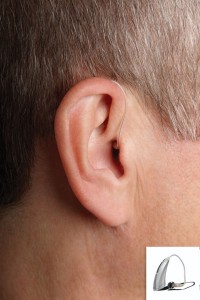 Receiver-in-Canal (RIC)
Receiver-in-Canal (RIC)
Receiver-in-canal (RIC/RITE) hearing instruments are worn behind the ear and come with tiny housings(smaller than traditional BTE’s). The receiver is connected to the hearing aid through a thin wire (not much thicker than dental floss)and sits directly in the ear canal. The receivers come in different sizes based on the patients hearing loss and ear diameter. RICs are easily adjusted and are quite commonly referred to as the most comfortable, discreet type of amplification.
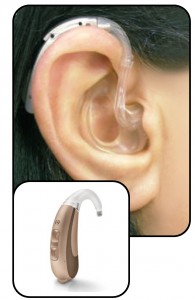 Behind-the-Ear (BTE)
Behind-the-Ear (BTE)
BTE hearing aids are among the most flexible and work with the widest range of hearing loss. Directional microphones, multiple listening programs and a tele-coil for compatibility are available for these models. The hearing aid is placed behind your ear and connects to a custom ear mould placed inside your ear. BTE hearing aids are powerful and durable, and among the most popular hearing devices. They can be fitted on the day of the hearing test, based on your diagnosis and prescription.
Invisible-in-the-Canal (IIC)
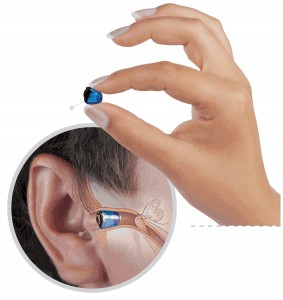 Like CIC’s, these cosmetically discreet instruments are custom made to fit inside your ear canal. However, IIC devices sit deeper (beyond the second bend of the canal). Because they’re deeper in the ear, they’re not at all apparent and typically come in shades to mimic the shadows of the ear.
Like CIC’s, these cosmetically discreet instruments are custom made to fit inside your ear canal. However, IIC devices sit deeper (beyond the second bend of the canal). Because they’re deeper in the ear, they’re not at all apparent and typically come in shades to mimic the shadows of the ear.
In the Ear (ITE)
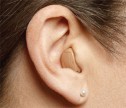 ITE hearing aids are custom-made from an impression of your ear canal, and have no visible wires or tubes. ITEs are placed inside the ear, are lightweight and less visible than BTE devices. These devices are commonly used for those with a moderate hearing loss.
ITE hearing aids are custom-made from an impression of your ear canal, and have no visible wires or tubes. ITEs are placed inside the ear, are lightweight and less visible than BTE devices. These devices are commonly used for those with a moderate hearing loss.
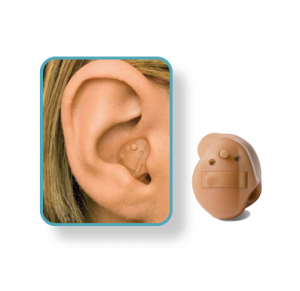 In the Canal (ITC)
In the Canal (ITC)
ITCs are custom-fitted and placed inside the ear canal. There are no wires and sound is funneled through the hearing aid for clarity. ITCs are appropriate for mild to severe hearing loss. The size of the ear may limit use of this type of device.
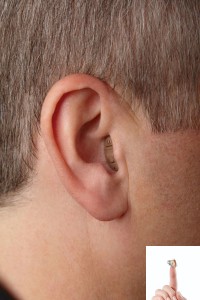 Completely in the Canal (CIC)
Completely in the Canal (CIC)
With CICs, the entire hearing aid is placed deep inside the ear canal, making them the least visible. CICs are custom fitted to the wearer’s ear canal, are very small in size and are almost invisible. They sit very close to the eardrum, which helps improve sound quality and reduce echoing.
WHAT TO EXPECT FROM YOUR HEARING INSTRUMENT
Although a hearing aid won’t restore normal hearing, with hearing instruments, you should be able to hear many sounds that you couldn’t hear without one. People notice more sounds, such as a ticking clock, that were not noticeable before. The new ability to hear in more detail takes a little getting used to.
- Hearing instruments help many people hear better, but they don’t restore normal hearing.
- Hearing devices can be custom-fitted so they are comfortable. Re-fitting may be needed, at times, to maintain a perfect fit. Hearing loss occurs gradually.
- Learning to hear sounds again with a hearing aid is also a gradual process, but people adjust over time.
ADJUSTING TO A HEARING AID
At first, sounds may seem unnatural. As the brain adjusts to hearing again, things will sound more natural. The adjustment period usually lasts a few weeks, and can take up to a few months.
FITTING YOUR HEARING DEVICE
Part of the fitting process is fine-tuning your instruments to your particular hearing needs.
This usually takes place over several sessions, after you have worn the instrument in different environments. Your feedback to your hearing care professional can help make the adjustments you need.
Your audiologist will know the options available, technical aspects of the hearing devices and help you choose the right solution for your needs. If you are ready to hear better, give us a call, and we will help you find the perfect fit.
While surgical intervention may be the optimal treatment for many individuals with hearing impairment, patient preference and their unique medical circumstances may dictate an alternate course.
Recent advances in digital hearing aid technology have vastly improved the lives of millions of individuals with the hearing loss that typically develops in the 50’s and 60’s, sometimes earlier depending on family predisposition.








